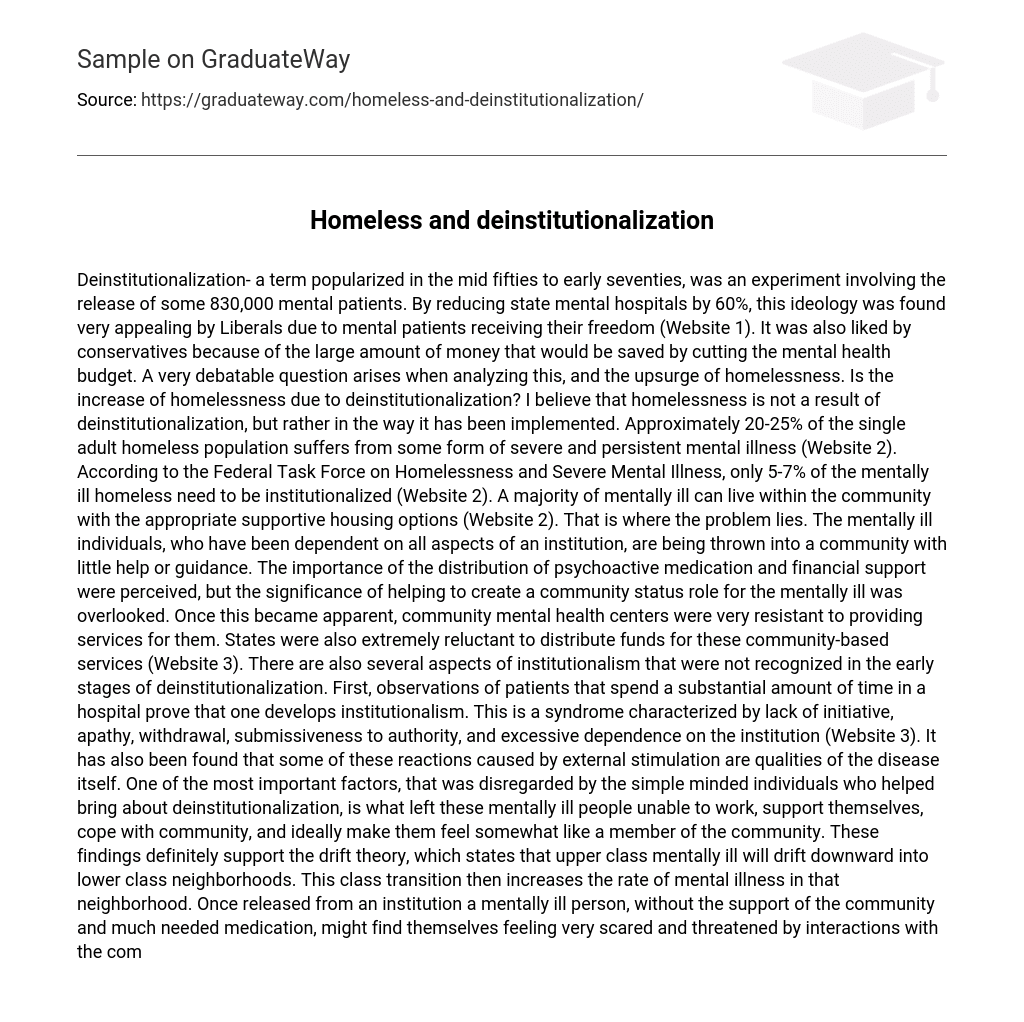Deinstitutionalization, which gained popularity from the mid 1950s to early 1970s, was an experiment that involved releasing approximately 830,000 mental patients. This ideology, which aimed to reduce state mental hospitals by 60%, appealed to both Liberals and conservatives for different reasons (Website 1). Liberals saw it as an opportunity for mental patients to regain their freedom, while conservatives saw it as a way to save a significant amount of money by cutting the mental health budget. However, this experiment triggered a controversial debate regarding the sudden increase in homelessness.
The increase in homelessness is not solely caused by deinstitutionalization, but rather by the way it has been implemented. Website 2 states that approximately 20-25% of single homeless adults suffer from severe and persistent mental illness. The Federal Task Force on Homelessness and Severe Mental Illness reveals that only 5-7% of mentally ill homeless individuals need institutionalization. As long as they have access to suitable supportive housing options, most people with mental illnesses can live in the community. Therefore, the challenge lies in providing appropriate community-based housing solutions.
According to Website 3, mentally ill individuals who have relied on institutions for support are now being placed in communities without adequate assistance. While the importance of providing medication and financial aid was recognized, the need for establishing a social role for the mentally ill in the community was overlooked. As a result, community mental health centers initially hesitated to offer services, and states were unwilling to allocate funds for these community-based programs.
The early stages of deinstitutionalization did not recognize several aspects of institutionalism. Patients spending a significant amount of time in a hospital are observed to develop institutionalism, which is characterized by lack of initiative, apathy, withdrawal, submissiveness to authority, and excessive dependence on the institution (Website 3). It has also been discovered that some of these reactions caused by external stimulation are inherent qualities of the disease itself. The individuals involved in deinstitutionalization overlooked an essential factor – the reasons why mentally ill individuals were left unable to work, support themselves, cope with community life, and feel like members of the community. These findings support the drift theory, which suggests that upper class mentally ill individuals will gravitate towards lower class neighborhoods.
The deinstitutionalization of mentally ill individuals in this class leads to a higher occurrence of mental illness in the community. When discharged from an institution, mentally ill individuals may experience intense fear and vulnerability when interacting with the community, especially without the support of their peers and necessary medication. This highlights another problem: the link between crime and mental illness. About one thousand deaths in the United States are caused by severely mentally ill individuals who do not receive proper treatment. These homicides make up approximately 5% of all killings nationwide, underscoring the importance of following every stage of deinstitutionalization.
The insanity defense is utilized to determine the degree to which individuals charged with crimes can be exempted from criminal responsibility based on their mental illness. The jury, relying on expert witnesses in psychology, ultimately decides whether someone is mentally ill or not. This determination determines whether these individuals are placed in a mental facility, imprisoned, or set free. As a result, various issues arise from the presence of the insanity defense including difficulties in ascertaining mental illness, discovering appropriate placements for mentally ill offenders, and assessing the overall effectiveness of this defense.
Insanity, a legal concept distinct from mental illness, should not be conflated with it. Applying medical theories to legal matters becomes challenging due to the fact that not all mental illnesses are categorized as insanity.
According to Website 5, the Durham Rule is a method used to determine insanity. It suggests that insanity includes various personality factors which may be found in every case. The credit for establishing this rule goes to Judge David Bazelon during the Durham vs. U.S. case.
The author argued for the rejection of the M’Naghten Rule, stating that individuals should not be held criminally responsible if their illegal act was a result of a mental disease or defect. However, accurately defining mental disease or defect poses challenges in interpreting this rule. Additionally, the term “product” does not provide clear guidelines for juries to make decisions. In Texas, there is currently a person on death row who was diagnosed with paranoid schizophrenia at 21 years old. His family was unaware of his condition during his teenage years because he was adopted. This case demonstrates deinstituitionalization since he was repeatedly denied treatment after diagnosis due to non-violence and limited availability of hospital beds (Website 6).
Despite being aware of his need for medication and counseling, institutions repeatedly admitted him for approximately thirty days and then discharged him due to his non-violent behavior. However, he ultimately committed a violent act by killing five individuals. Currently, Larry is on death row and, despite discovering records indicating that five other biological relatives also suffer from this illness, he is denied a sanity hearing.
Based on my extensive research on community shelters and treatment centers, it has become evident that these institutions either fail to fulfill their responsibilities adequately or lack the necessary funding to do so. As a result, I strongly believe that certain mentally ill individuals require extended residency in specialized facilities.
There are individuals who struggle to adapt to society and cannot function independently as community members on a daily basis. I believe we should reevaluate the deinstitutionalization process for those who can adjust. The current approach of relying on emergency homeless shelters and short institutional stays is ineffective. Instead, we should embrace these individuals into our community rather than excluding them due to an uncontrollable difference. By providing sufficient financial assistance, guidance, and medication, I am confident that we would witness an increase in mentally ill individuals who depend partially on others.
The bibliography lists the following websites:
Website1 – http://csf.colorado.edu/mail/homeless/feb99/0037.html
Website2 – http://nch.ari.net/causes.html
Website3 – http://wwwlinteractivist.net/housing/deinstitutionalization_1.html
Website4 – Not specifically mentioned.
The mentioned websites are: Website5, Website6, and Larry’s Website.





